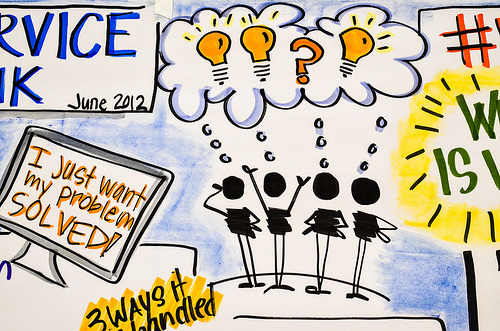No customer service is an island. You just can’t deliver great customer care alone.
These days, customers are tech-savvy, creative, and communicative. Some customers may want to build extensions and plugins to your service. In fact, we owe many of our iDoneThis “goodies” to ingenious users who built them to better suit their workflow. Others request features or find ways to adapt your tool to their company culture that you never initially considered. Still other customers ask highly technical questions. They all use multiple channels to communicate a volley of varied issues.
The worst customer experience is to wait forever for an answer, only to receive a meaningless response. That’s bound to happen when you isolate your customer service team. Ill-equipped to substantively deal with issues, they leave customers hanging while running around asking developers for assistance.

The best customer experience is prompt, personal resolution of a problem, and this starts with a foundation of strong internal team connections and communication. The better your team is at communicating and supporting each other, the better the customer service results. Customer requests will have a faster turnaround, your responses will be more substantive and helpful, and your customers will simply be happier.
Here’s some key ways and tools to connect your team internally for excellent customer service:
1. Everybody pitches in for customer service
Customers need more than one designated “customer service” person, or one department. Your customer happiness team needs to keep up with the product’s marketing and development, and your product developers need to stay in touch with issues rolling in.
Everyone on your team, from your developers to your CEO, should handle some customer service communications. At iDoneThis, the CEO, the CTO, and the developers all pitch in to help with customer support. It’s a valuable way for everyone to have a finger on the pulse of customer experiences.
2. Know your team’s strengths
Know which team member is best equipped to respond to a request and most knowledgeable about a particular question or a particular customer. Not all questions require an expert answer, but all questions should get a speedy response, so assign accordingly.
At iDoneThis, we use programs like Help Scout to assign and track customer service emails. Not only do I take into account the team member’s area of expertise when assigning a customer issue, I also use Help Scout to see who has connected with that client before.
3. Provide support for your own team.
Be cognizant of each team member’s task load. If team members are overwhelmed with work and a customer service issue has been languishing, step in to assist and move things along. Can you check on something in the system for them? Does their answer need confirmation from another party? If they possess unique knowledge necessary for the issue, get a short answer and communicate with the customer on their behalf. If necessary, assign the customer support issue to someone else.
We use iDoneThis to stay connected with each other and see who is busy doing what. By filling out and sharing our iDoneThis entries each day, the whole team can see whether someone has gotten around to a customer issue or has been otherwise occupied. This makes it easy to effectively distribute and reassign issues and for others to step in and help, giving the customer a faster response time.

4. Maintain constant, real-time communication.
You’ll invariably run into customer service issues that require quick answers from different people on your team. Sometimes, a “yes” or “no”, or a short confirmatory response, will do. Sending an email and waiting for a response can be inefficient and unpredictable. If your team can communicate in real-time, however, the response time is most likely to be just a few minutes.
Internal communication programs like Campfire are group chat rooms for your team, enabling instant communication, all day long. Questions are resolved quickly, and no time is wasted replying to the customer.
5. Educate each other on customer issues after resolution.
Learn collectively from customer experiences and resolution of problems in order to deliver better service and a better product in the long run. This way, the development team can correct systemic issues, make key improvements to the product, and preempt the occurrence of certain problems. The customer service team learns to handle a broader range of issues and expands substantive knowledge about the product.
At iDoneThis, we use GitHub to share problems we encounter in customer service. By creating tickets, we alert and educate each other about any long-term improvements and changes needed to enhance the product. We also use Github’s wiki feature to write step-by-step guides to resolving common customer service requests, equipping everyone on the team — newbies and experts alike — to address frequently asked questions.
Excellent customer service relies on strong internal connections within your team.
Your customer service agents cannot deliver quick, constructive, personal resolutions if they are isolated from the rest of the team. The rest of your team cannot deliver the best possible product if they are isolated from customer service.
Internal social collaboration tools are an easy solution. With a few online tools, you can ensure that the whole team develops personal rapport with customers, leverages individual strengths in supporting customers, and supports each other. This, in turn, will inspire and enable each of them to deliver rapid, responsive and happy customer service experiences.
Liked this post? Subscribe to our free newsletter for more great content on entrepreneurship, productivity, and company culture!
Images: [1] Dell/Flickr; [2] Natasha Mileshina.
